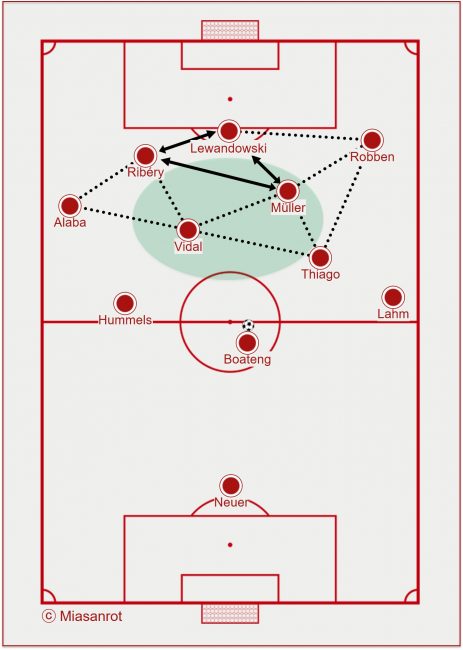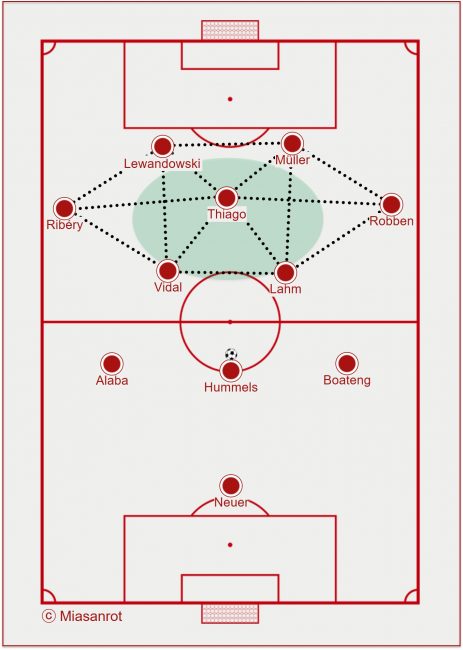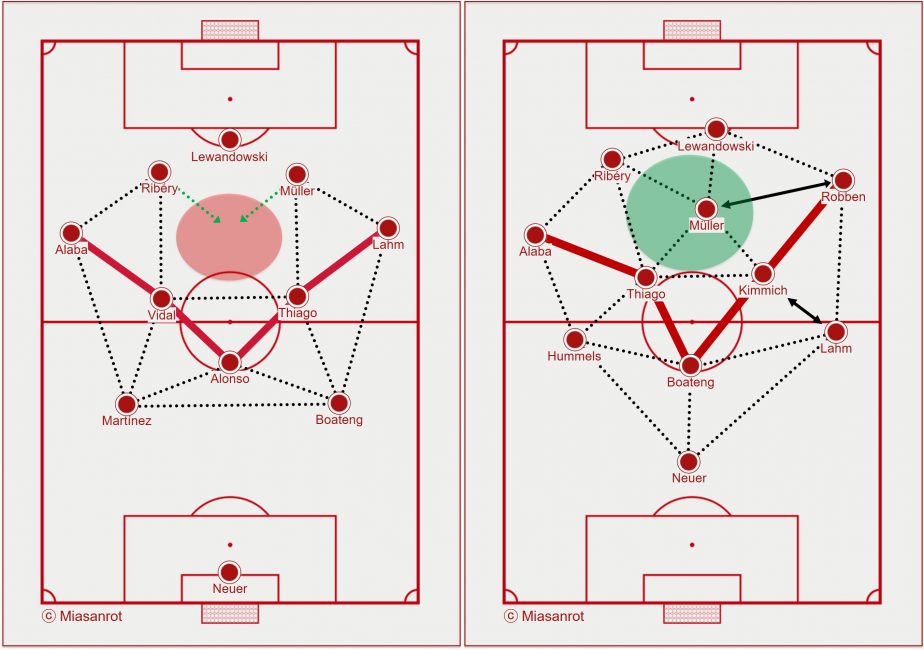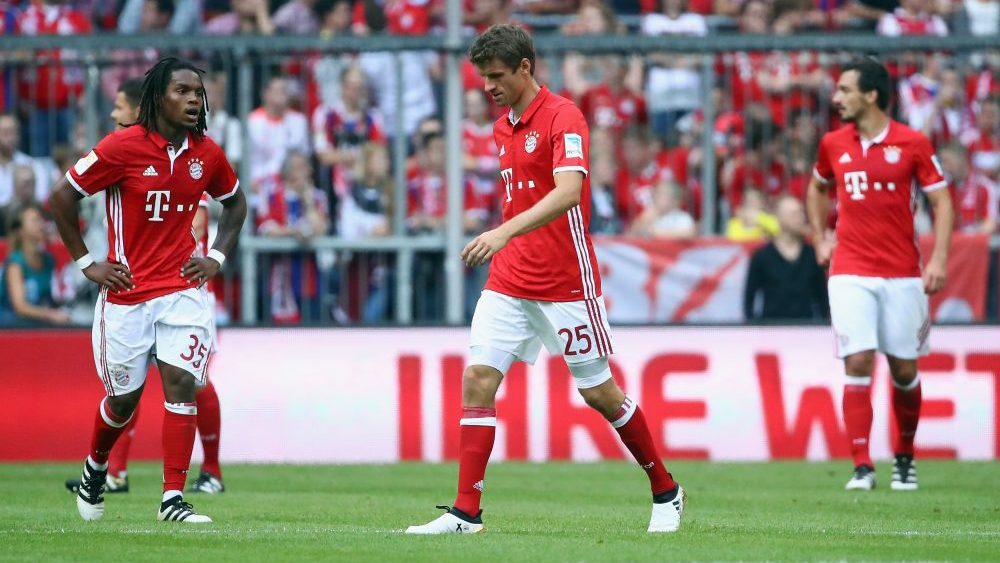Carlo Ancelotti: Problematic zone 14
There are a lot of possibilities to visualise tactics. Particularly popular is splitting the pitch into different areas. In the teaching of positional play dividing it into 18 zones is common. A very important one is the so-called zone 14. It is the central space between the lines of the opponent or the space of the playmaker. Here you can read more about the importance of this area.
The basic problem
We have already talked about the V-structure of the Italian coach a couple of days ago. There we noticed, that often zone 14 isn’t occupied and if it is, it’s mostly by a player who opens up space elsewhere. For instance Franck Ribéry likes to use this space to support his teammates in the centre. If one wants to be dangerous through the middle a clean occupation between the lines is necessary.
 In the Ancelotti-V zone 14 is often left unoccupied.
In the Ancelotti-V zone 14 is often left unoccupied.The problem hereby lies in the fact, that with the full-backs pushing forward coverage for the half-space is necessary, too. The central midfielders usually move out wide and try to react on turnovers. Consequently, Bayern are occupying the wings well. After early struggles they create triangle there and combine until the opposition’s 18-yard box. So far, FC Bayern played via the wings up to 73% (34% left, 27% central, 39% right). In Guardiola’s last year it was more balanced (35% left, 31% central, 34% right).
One of the disadvantages of the Ancelotti-structure is the focus on the wings, because the playmaker space isn’t occupied well, as well as the increased number of crosses. At the moment it’s 19 crosses per game on average, three more than last season. With the actual wingers moving inside and the full-backs taking over their position the dribbling stats are dropping as well. Currently it’s 21 per game and thus making it 6 less than in the last Guardiola season. To be fair, it’s worth noting that FC Bayern has played with only one genuine winger for the majority of games so far.
Individual statistics prove however, that Munich is currently not only too dependent on the wings, there’s also hardly any creativity to break into the penalty area. David Alaba crosses the ball 6.7 times per 90 minutes for example. Last season this figure stood at 1.2 per game when he played full-back. He plays a lot more balls into the box, because he doesn’t have the 1vs1 qualities other players have in the squad. The support in zone 14 is bad as well.
For the most part Bayern are missing a net, which gives the attacking play structure. The fact he has to occupy the central attacking areas with enough players, without losing penetration on the wings is a dilemma for Ancelotti. The current playing style will suffice against many teams but the game in Madrid showed how important clean occupation of the central space is. How can the Italian occupy this zone more consistently, provoke 1vs1 situations on the wing and provide protection for turnovers?
Three in the back to create offensive structure
On paper this all sounds rather easy, because the rejection of the 2-3-staggering in the build-up would solve a lot. With the right personnel one could even find good attempts at trying to solve the problem with Thomas Müller. The back three brings a lot of options and could provide more players between the lines of the opponent with its structure. There are different variants for this structure.
Asymmetric wingers
The basic order wouldn’t change much with a few asymmetries. Merely the positional play would change slightly. With Philipp Lahm and David Alaba FC Bayern has to full-backs, who possess above average passing skills.
 In an asymmetrical 4-3-3 Müller, Lewandowski and Ribéry alternate on occupying the zone 14.
In an asymmetrical 4-3-3 Müller, Lewandowski and Ribéry alternate on occupying the zone 14.One of the two could position himself deeper to take up a safeguarding role against counter-attacks. In an ideal case that would probably be the captain as Alaba is better going forward. The Austrian pushing forward would mean, that Ribéry could still hold his free role as an inside forward. On the other side there would be an opportunity for Robben to seek more width. One has to get the Dutchman into promising 1vs1 duels there.
The most important modification in this system would affect the centre, though. Müller, Lewandowski and Ribéry would be constantly move in and out of the zone, but could combine for a frequent and consistent occupation of the zone. Especially Thomas Müller is comfortable in this role. From there he can work around the striker, support the wings through the half-spaces and open gaps in important zones with his smart runs off the ball. It’s the proven ideal position for the 27-year old. Through the flexibility of this offensive structure there would be at least enough movement theoretically to crack the chains of a well-organised opponent. A central midfielder, e.g. Vidal, could overload the offensive centre if the situation enables it. The asymmetrical set-ups would ensure good occupation on the wings. Through the swap of a central midfielder with the more attacking Thomas Müller there would be more players in central interspace. This idea would shift Carlo Ancelotti’s V a bit and brings more presence in the playmaker space. However, there’d still exist players for coverage and the occupation of the wings wouldn’t come off short through connections all over the field. The biggest advantage of this structure may be the direct access on the opponent after turnovers. Interpreted bravely it’s ideal for good counter-pressing.
Thiago as true playmaker, Lahm in a hybrid-role
Obviously there’s an option to occupy zone 14 more rigidly. Reasonably, because the movement patterns in Bayern’s play are so flexible, that positional switches happen all the time.
 Thiago as playmaker in a 3-2-3-2.
Thiago as playmaker in a 3-2-3-2.With Thiago there’s a player in the own ranks, who has the technical ability to play in a high-upfield playmaker role. He creates connections and can play a deadly pass at any time. Skills Mario Götze also possessed by the way. Thiago is also an often underrated tackler. In counter-pressing he could attack in the first line and dictate the play of the team against the ball. In the Bundesliga the Spaniard wins 57% of his tackles and does that through smart movement out of the chain.
The 25-year old is ahead of an decisive season anyway. His performance will have a big influence on the success of Bayern. So far he’s never been a game-changer throughout a whole season. This could change for the first time. In the first weeks the national team player has shown already that he can take over the centre. In the toughest game up to date against Atlético Madrid he was the most striking Bayern player. Thiago possesses the intelligence for this demanding position and could inherit the potentially most important position in a 3-2-3-2 system for example.
This formation was seen under Guardiola time and time again. Executed correctly it creates a net all over the pitch and creates triangles everywhere. Moreover, it’s easily convertible into a 4-1-4-1, 4-2-3-1 or 4-4-2 against the ball. Even a back five would be possible without massive adjustments.
The best options for a flexible system are Joshua Kimmich and Philipp Lahm. Both can play different positions and would enable different formations during the game in their hybrid roles. Last season Lahm played as right-back and central midfielder at the same time. The captain probably had his strongest period there in the last few years. He’s able to dominate a match from that position. Why not go back to a system that would elevate Germany’s best player of his generation again?
Using the variety of options
Ancelotti is deemed to be a pragmatist. In 9 games the spectators saw the 4-3-3 system 9 times. It’s unlikely that something will change about that anytime soon. Nevertheless the Italian should consider bringing back the back three. It doesn’t only solve the question how Bayern gets more players between the lines but rather simplify the build-up, too.
He has all the options. Against stronger opponents he could field five world-class defenders in Martínez, Hummels, Boateng, Alaba and Lahm. The system allows the use of five attacking players as well. If one wants to take on deeper opponents the “Line-up of Death” could make its comeback.
The Bayern manager wouldn’t even have to shuffle around the basic set-up to operate with a back three. His 4-3-3 allows the aforementioned asymmetries and with better positional play create structures faster that would help Bayern’s attacking play.
Conclusion: More courage in the centre
Ultimately, the problems in the centre are down to the deep position of the midfield trio. The central midfielders rarely push forward. Even rarer is a push forward by any of the three players to overload the central offence like Schweinsteiger did in his prime at FC Bayern. Joshua Kimmich is most suited to this role. The 21-year old, Vidal and Thiago worked best in Bayern’s midfield.

Ancelotti has the option to either swap a central midfielder for Müller, use asymmetrical positioning for better structure in the playmaker space or let the central midfielders operate higher up the pitch in general. In any case, he has to occupy this area more consistently and create more connections between the attacking players. If the 57-year old can convert the problem zone 14 into a creative area it will be a decisive factor on his success in Munich.












Excellent analysis.
Thank you
Off the pitch question..do you see martinez in midfield with either one of vidal or thiago?
Hey Sahid,
I’d love to see him in a mix role. Martínez could play CB against the ball and Midfield in possession.
Thanks for your opinion Justin. I think too that Carlo needs to fix this Zone 14 as soon as possible.
[…] does not have a real vertical passing option. Furthermore no one occupies the ten space. The picture makes clear the Real midfielders don´t offer passing options between the opponent […]
[…] does not have a real vertical passing option. Furthermore no one occupies the ten space. The picture makes clear the Real midfielders don´t offer passing options between the opponent […]
[…] does not have a real vertical passing option. Furthermore no one occupies the ten space. The picture makes clear the Real midfielders don´t offer passing options between the opponent […]